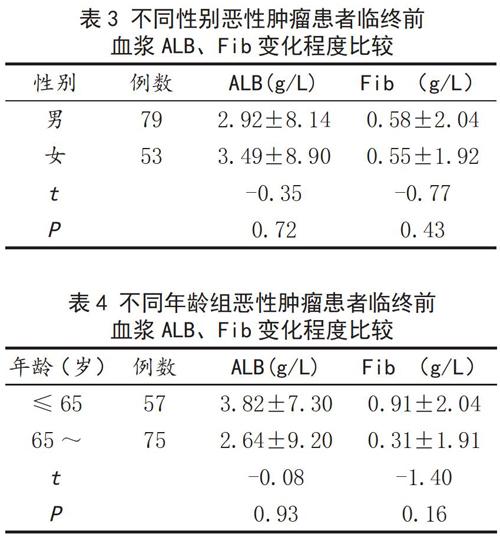恶性肿瘤临终患者血浆ALB及Fib水平变化规律及其相关性
2020-05-14蔡腾腾步玉晴崔玉洁田磊魏亚红张洪珍
蔡腾腾 步玉晴 崔玉洁 田磊 魏亚红 张洪珍



摘要 目的:分析恶性肿瘤患者临终前血浆白蛋白(ALB)、纤维蛋白原(Fib)水平的变化与预后的关系。方法:收集132例恶性肿瘤患者临终前1个月内和1~3个月内的血浆ALB、Fib检测值,并对两次检测值进行统计分析。结果:恶性肿瘤患者临终前1个月内血浆ALB、Fib检测值低于1~3个月内检测值,差异由统计学意义(P<0.01);肺癌及消化系统肿瘤中,血浆ALB两次检测值差异有统计学意义(P<0.05);泌尿系肿瘤、妇科肿瘤、乳腺癌两次检测值呈下降趋势,但差异无统计学意义(P>0.05)。消化系统肿瘤及乳腺癌中,患者临终前1个月内血浆Fib检测值明显下降,差异有统计学意义(P<0.05),肺癌、泌尿系肿瘤、妇科肿瘤中血浆Fib两次检测值具有下降趋势,但差异无统计学意义(P>0.05)。血浆ALB和Fib水平变化与性别和年龄无关(P>0.05),且血浆ALB和Fib之间不存在相关性(P>0.05)。结论:血浆ALB及Fib变化情况可以作为恶性肿瘤患者临终前评估预后的指标。
关键词 血浆白蛋白;纤维蛋白原;恶性肿瘤;临终;预后
中图分类号 R73 文献标识码 A 文章编号 1671-0223(2020)06-028-05
CHANGES AND CORRELATION OF PLASMA ALB AND FIB LEVELS IN TERMINAL PATIENTS WITH MALIGNANT TUMORS Cai Tengteng,Bu Yuqing,Cui Yujie,et al.Hebei General Hospital,Shijiazhuang 050051,China
Abstract Objective To analyze the relationship between the level of plasma albumin (ALB) and fibrinogen (Fib) and prognosis in patients with malignant tumors before dying. Methods The plasma ALB and Fib values of 128 patients with malignant tumors were collected within 1 month and 1-3 months before dying, and statistical analysis was performed on the two values. Results The detection values of plasma ALB and Fib in patients with malignant tumors were lower than those in 1-3 months before dying (P<0.01). In lung cancer and digestive tract malignant tumors, the difference of plasma ALB measurements was statistically significant (P<0.05); The urinary tumor, gynecological tumor, and breast cancer showed a downward trend, but there was no statistical difference (P>0.05). In digestive tract malignancies and breast cancer, the plasma Fib test value decreased significantly within 1 month before the end of dying (P<0.05).The two levels of plasma Fib in lung cancer, urinary tumor and gynecological tumor showed a downward trend, but there was no statistical difference (P>0.05).Plasma ALB and Fib levels were not associated with gender and age (P>0.05). Besides, there was no correlation between plasma ALB and Fib (P>0.05). Conclusion Changes in plasma ALB and Fib can be used as indicators of prognosis in patients with malignant tumors before dying.
Key words Albumin;Fibrinogen;Malignancy;Death;Prognosis
世界范圍内恶性肿瘤患者的死亡率逐年上升,2018年中国癌症死亡约占全球癌症死亡的 30%[1]。随着恶性肿瘤诊断技术及治疗方式的不断进展,恶性肿瘤患者预后指标的选择也越来越被重视。机体的营养状态及凝血功能可以用于判断恶性肿瘤患者的预后[2-5],血浆白蛋白(Albumin, ALB)及纤维蛋白原(Fibrinogen, Fib)可以反应人体营养状态及凝血功能,近年来ALB及Fib被广泛应用于判断恶性肿瘤患者的预后[6-8]。尽管如此,目前关于恶性肿瘤临终患者血清ALB及Fib水平变化情况与预后关系的研究较少,且大部分研究针对某种特定类型的恶性肿瘤。本研究对132例恶性肿瘤临终患者临终前1~3个月血清中ALB及Fib检测值与临终前1个月ALB及Fib检测值的水平变化进行回顾性分析,以期探索恶性肿瘤临终患者ALB及Fib水平变化对预后评估的临床意义。
1 对象与方法
1.1 研究对象
选取2016年8月至2019年8月在河北省人民医院肿瘤科住院并死亡的诊断为恶性肿瘤患者132例为研究对象,其中男79例,女53例;年龄25~93岁,中位年龄67岁;肺部恶性肿瘤39例,消化系统肿瘤50例,泌尿系恶性肿瘤13例,乳腺恶性肿瘤7例,妇科恶性肿瘤15例,其他恶性肿瘤8例。所有收集资料均为临终前1个月内及1~3个月的凝血及生化检查结果。
1.2 指标检测
所有患者采外周静脉血2mL,置于枸橼酸钠真空抗凝管内,充分混匀,送至本院生化室,离心 10 min,分离得到血浆。严格按照说明书进行ALB及Fib检测。ALB采用贝克曼库尔特生化分析系统白蛋白测定试剂盒(溴甲酚绿法);Fib采用SIEMENS纤维蛋白原测定试剂(凝固法)。查阅患者病历资料及病检结果,收集临床资料,包括:年龄、性别、病理类型等。
1.3 统计学处理
采用SPSS25.0软件进行数据统计分析,计量资料符合正态分布以“均数±标准差”表示,两组均数比较采用配对t检验;不符合正态分布的以“中位数(四分位数间距)”表示,组间中位数比较采取Wilcoxon秩检验;两组关系分析采用Spearman相关分析;P<0.05为差异有统计学意义。
2 结果
2.1患者临终前血浆ALB、Fib检测结果
恶性肿瘤患者临终期1个月内血浆ALB及Fib测定值较1~3个月时明显降低,差异有统计学意义(P<0.05),见表1。
2.2 不同恶性肿瘤患者临终前血浆ALB、Fib检测结果
将研究人群分为肺癌组、消化系统肿瘤组、泌尿系肿瘤组、妇科肿瘤组及乳腺癌组。肺癌组及消化系统肿瘤组患者血浆ALB临终前1个月内明显下降(P<0.05),其他各组血浆ALB检测值具有下降趋势,但差异无统计学意义(P>0.05);消化系统肿瘤组及乳腺癌组患者血浆Fib临终前1个月内明显下降(P<0.05),而其余各类肿瘤有下降趋势,但差异无统计学意义(P>0.05),见表2。
2.3 不同性别恶性肿瘤患者临终前血浆ALB、Fib变化程度比较
以血浆ALB、Fib “临终前1~3个月检测值-临终前1个月检测值”作为评价变化程度的指标,结果显示,不同性别间血浆ALB、Fib变化程度差异均无统计学意义(P >0.05),见表3。
2.4 不同年龄恶性肿瘤患者临终前血浆ALB、Fib变化程度比较
按照患者年龄分为两组,比较不同年龄恶性肿瘤患者临终前血浆ALB、Fib变化程度。结果显示,恶性肿瘤患者临终前血浆ALB、Fib变化程度年龄组间差异均无统计学意义(P>0.05),见表4。
2.5 恶性肿瘤患者临终前血浆ALB与Fib相关性分析
分别分析恶性肿瘤患者临终前1个月内及1-3个月内血浆ALB与Fib之间的相关性。结果显示,两个观察时间点血浆ALB与Fib均无相关性(P>0.05),见表5。
3讨论
随着恶性肿瘤细胞不断的增殖,机体蛋白质分解代谢增强,而合成能力降低,这样的高分解代谢状态容易导致机体营养不良[6]。营养不良状态又可以导致机体 免疫能力下降,进而影响恶性肿瘤患者的预后。由于肿瘤细胞具有很强的促凝活性,恶性肿瘤患者往往伴有凝血和纤溶系统的激活,体内凝血指标将明显升高[9-11]。患者体内的高凝状态可以导致血栓的形成[12],也可以诱导DIC形成[13],从而影响恶性肿瘤患者的预后。本研究通过分析恶性肿瘤患者临终前两次血浆ALB及Fib检测值水平变化,为判断恶性肿瘤临终患者的预后提供依据。
研究显示恶性肿瘤患者营养不足发生率在40%~80%之间,营养风险发生率为39%~68%[14],临床上常用血液学检测指标结合体格测量来评估患者营养状态[15],在血液学指标中,ALB水平是最常应用的一项评估指标。血浆ALB是由肝脏实质细胞合成,可以作为小分子有机物和无机离子等许多物质的转运载体,并且维持血浆胶体渗透压,然而血浆ALB水平降低会引起体内环境紊乱,导致机体代谢异常。多项研究表明血浆ALB降低与肿瘤不良预后相关[16-18]。目前很多研究仅针对特定肿瘤患者血浆ALB进行单次测定分析与预后之间的关系[19-21]。然而,通过对恶性肿瘤患者临终前血浆ALB水平变化检测,能够更直接的表明患者血浆ALB水平与病情变化之间的关系。本研究通过对132例恶性肿瘤临终前1~3个月血浆ALB测定值与其1个月内检测值进行比较分析,初步证明了恶性肿瘤临终期患者血浆ALB水平随病情进展而下降,恶性肿瘤患者临终前1~3个月ALB检测水平显著高于1个月内检测水平,说明恶性肿瘤病情的进展伴随着营养消耗,血浆ALB水平降低与恶性肿瘤临终期患者预后不良相关。对不同恶性肿瘤患者进行亚组分析,肺癌和消化系统肿瘤终末期患者血浆ALB水平下降;泌尿系统肿瘤、乳腺癌、妇科肿瘤临终期患者血浆ALB具有降低趋势,但无统计学差异,可能是样本量较少导致。此外,本研究分析了男性和女性之间血浆ALB两次检测值的变化情况,发现血浆ALB的变化水平与性别和年龄无关。因此,本研究显示的恶性肿瘤患者临终前ALB较前下降,可以作为临终期恶性肿瘤患者判断预后的一项指标。
研究表明[22-23],恶性肿瘤与机体凝血功能之间存在着紧密联系。Fib又被称为凝血因子I,主要由肝细胞合成,Fib不仅可以与肿瘤细胞相互粘附,更可以促进肿瘤细胞与血小板相互粘附,形成微血栓,促进肿瘤细胞逃逸机体免疫,增强肿瘤细胞侵袭及转移能力。目前多数研究[24-27]证实Fib水平升高与多种恶性肿瘤的预后存在正相关。本研究比较132例临终前患者Fib两次检测值变化水平,结果显示临终前1个月内患者较1~3个月Fib降低。分析原因可能与既往研究人群未在临终期,而临终期患者机体处于衰竭状态,肝脏合成Fib能力下降,导致Fib水平下降。也可能由于恶性肿瘤细胞釋放促凝物质,使机体处于高凝状态,更加容易诱导DIC发生[28-29]。有研究显示,肿瘤细胞释放的组织因子与 DIC 的发生发展存在密切联系[30]。DIC使体内凝血因子被消耗,引起Fib水平降低。有研究表明晚期肿瘤患者DIC发生率占24%~34%[31],恶性肿瘤合并DIC死亡率高达85.1%[32]。亚组分析显示消化系统肿瘤及乳腺癌终末期患者血浆Fib水平下降;肺癌、泌尿系统肿瘤、妇科肿瘤临终期患者血浆Fib存在下降趋势,但没有统计学意义。本研究分析了不同性别和年龄之间血浆Fib两次检测值的变化情况,未发现血浆Fib的变化水平与性别和年龄具有相关性。有研究显示不同胃癌阶段血浆ALB降低与Fib升高之间存在相关性[33],但该研究未纳入临终期患者。而本研究显示血浆ALB与Fib两者之间并无相关性。因此,本研究显示恶性肿瘤患者临终前Fib下降,可以作为判断预后的指标。
綜上所述,通过对恶性肿瘤死亡患者血浆ALB、Fib的动态监测,可以判断患者的病情变化,血浆ALB及Fib水平与病情及预后具有相关性,对终末期恶性肿瘤预后具有一定预测价值。
4参考文献
[1] 王宁, 刘硕, 杨雷, 等. 2018全球癌症统计报告解读[J]. 肿瘤综合治疗电子杂志, 2019,5(01):87-97.
[2]Mantzorou M, Koutelidakis A, Theocharis S, et al. Clinical Value of Nutritional Status in Cancer: What is its Impact and how it Affects Disease Progression and Prognosis?[J]. Nutr Cancer, 2017,69(8):1151-1176.
[3] Agnelli G, George D J, Kakkar A K, et al. Semuloparin for thromboprophylaxis in patients receiving chemotherapy for cancer[J]. N Engl J Med, 2012,366(7):601-609.
[4] Agnelli G, George D J, Kakkar A K, et al. Semuloparin for thromboprophylaxis in patients receiving chemotherapy for cancer[J]. N Engl J Med, 2012,366(7):601-609.
[5] Ravasco P, Monteiro-Grillo I, Camilo M. Individualized nutrition intervention is of major benefit to colorectal cancer patients: long-term follow-up of a randomized controlled trial of nutritional therapy[J]. Am J Clin Nutr, 2012,96(6):1346-1353.
[6] Egenvall M, Morner M, Martling A, et al. Prediction of outcome after curative surgery for colorectal cancer: preoperative haemoglobin, C-reactive protein and albumin[J]. Colorectal Dis, 2018,20(1):26-34.
[7] Vazeille C, Jouinot A, Durand J P, et al. Relation between hypermetabolism, cachexia, and survival in cancer patients: a prospective study in 390 cancer patients before initiation of anticancer therapy[J]. Am J Clin Nutr, 2017,105(5):1139-1147.
[8] Zhang Y, Xiao G. Prognostic significance of the ratio of fibrinogen and albumin in human malignancies: a meta-analysis[J]. Cancer Manag Res, 2019,11:3381-3393.
[9] 周波, 张卫宁, 白山, 等. 肺癌患者凝血功能指标变化及其临床价值[J]. 血栓与止血学, 2019,25(01):79-81.
[10] 吐尔逊江·艾力, 赵盼盼, 张涛. 乳腺癌患者凝血功能与肿瘤生物学特征的关系[J]. 中国医药导报, 2013,10(11):48-49.
[11] Beer J H, Haeberli A, Vogt A, et al. Coagulation markers predict survival in cancer patients[J]. Thromb Haemost, 2002,88(5):745-749.
[12] Lyman G H, Khorana A A. Cancer, clots and consensus: new understanding of an old problem[J]. J Clin Oncol, 2009,27(29):4821-4826.
[13]杨婷, 高清平. 弥散性血管内凝血患者的临床特征分析[J]. 内科急危重症杂志, 2016,22(03):194-198.
[14] Orrevall Y, Tishelman C, Permert J, et al. Nutritional support and risk status among cancer patients in palliative home care services[J]. Support Care Cancer, 2009,17(2):153-161.
[15] Correira P M, Santos C A, Almeida B J, et al. Scored Patient-Generated Subjective Global Assessment, albumin and transferrin for nutritional assessment of gastrostomy fed head or neck cancer patients[J]. Nutr Hosp, 2014,29(2):420-426.
[16] Shimura T, Toiyama Y, Hiro J, et al. Monitoring perioperative serum albumin can identify anastomotic leakage in colorectal cancer patients with curative intent[J]. Asian J Surg, 2018,41(1):30-38.
[17]Yamamoto M, Saito H, Uejima C, et al. Combination of Serum Albumin and Cholinesterase Levels as Prognostic Indicator in Patients ith Colorectal Cancer[J]. Anticancer Res, 2019,39(2):1085-1090.
[18] Wu M T, He S Y, Chen S L, et al. Clinical and prognostic implications of pretreatment albumin to C-reactive protein ratio in patients with hepatocellular carcinoma[J]. BMC Cancer, 2019,19(1):538.
[19] Long Z Q, Hua X, Zhang W W, et al. Prognostic impact of the pretreatment albumin to alkaline phosphatase ratio for nonmetastatic breast cancer patients[J]. Cancer Manag Res, 2019,11:4809-4814.
[20] Liu D Q, Li F F, Jia W H. Cumulative scores based on plasma D-dimer and serum albumin levels predict survival in esophageal squamous cell carcinoma patients treated with transthoracic esophagectomy[J]. Chin J Cancer, 2016,35:11.
[21] Onate Ocana L F, Aiello Crocifoglio V, Gallardo Rincon D, et al. Serum albumin as a significant prognostic factor for patients with gastric carcinoma[J]. Ann Surg Oncol, 2007,14(2):381-389.
[22] Palumbo J S, Kombrinck K W, Drew A F, et al. Fibrinogen is an important determinant of the metastatic potential of circulating tumor cells[J]. Blood, 2000,96(10):3302-3309.
[23] Zheng S, Shen J, Jiao Y, et al. Platelets and fibrinogen facilitate each other in protecting tumor cells from natural killer cytotoxicity[J]. Cancer Sci, 2009,100(5):859-865.
[24] Perisanidis C, Psyrri A, Cohen E E, et al. Prognostic role of pretreatment plasma fibrinogen in patients with solid tumors: A systematic review and meta-analysis[J]. Cancer Treat Rev, 2015,41(10):960-970.
[25] Sheng L, Luo M, Sun X, et al. Serum fibrinogen is an independent prognostic factor in operable nonsmall cell lung cancer[J]. Int J Cancer, 2013,133(11):2720-2725.
[26] Tas F, Kilic L, Bilgin E, et al. Clinical and prognostic significance of coagulation assays in advanced epithelial ovarian cancer[J]. Int J Gynecol Cancer, 2013,23(2):276-281.
[27] Son H J, Park J W, Chang H J, et al. Preoperative plasma hyperfibrinogenemia is predictive of poor prognosis in patients with nonmetastatic colon cancer[J]. Ann Surg Oncol, 2013,20(9):2908-2913.
[28] Iba T, Di Nisio M, Thachil J, et al. Revision of the Japanese Association for Acute Medicine (JAAM) disseminated intravascular coagulation (DIC) diagnostic criteria using antithrombin activity[J]. Crit Care, 2016,20:287.
[29] Levi M. Disseminated Intravascular Coagulation in Cancer: An Update[J]. Semin Thromb Hemost, 2019,45(4):342-347.
[30] Rickles F R, Falanga A. Molecular basis for the relationship between thrombosis and cancer[J]. Thromb Res, 2001,102(6):V215-V224.
[31] 張之南,沈悌. 血液病诊断及疗效标准[M]. 北京: 科学出版社, 2018.
[32] 陈慧敏, 赵冬, 王明珠. 老年恶性肿瘤患者并发弥散性血管内凝血危险因素及对预后的影响[J]. 中国肿瘤临床与康复, 2018,25(12):1499-1501.
[33] 李芳芳, 闫斌斌, 史笑梅, 等. 不同阶段胃癌患者高凝状态相关指标的变化及意义[J]. 肿瘤基础与临床, 2012,25(02):117-119.
[2020-02-10收稿]
基金项目:河北省重点研发计划健康医疗与生物医药专项(编号:18277718D)
作者单位:066000 河北省石家庄市,河北省人民医院
*通讯作者
